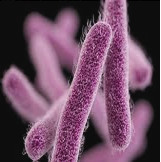Effects of Lactobacillus acidophilus and Lampung Robusta Coffee Extract on Shigella flexneri Induced Balb/C Mice; A Review of Colon Histopathology and Lymphocytes http://www.doi.org/10.26538/tjnpr/v7i5.18
Main Article Content
Abstract
Diarrhea is a disease that is still a health problem worldwide; one of the causes is Shigella flexneri. Non-dairy probiotic functional foods and beverages are gaining popularity, with researchers seeking to assuage consumer concerns regarding lactose intolerance and veganism. Coffee has anti-inflammatory and antibacterial properties. This study aims to determine the effect of a mixture of Lampung Robusta coffee extract and Lactobacillus acidophilus bacteria on the colon of BalbC mice that experience diarrhea after being induced by Shigella flexneri. Twenty 3- to 4- month-old mice weighing 35–50 grams were randomly divided into three treatment groups (125
mg/kg BW, 250 mg/kg BW, and 500 mg/kg BW) and a control group. The treatment and positive control groups were induced with Lactobacillus acidophilus 6x108 suspension using the sonde technique. The negative control group was not treated. Mice experienced diarrhea twice in 24 hours after induction. Each treatment group was given 0.4 ml of Lampung Robusta coffee extract and 0.5 ml of Lactobacillus acidophilus 1.5x108 for five days. On day 8, the colon of the mice was taken and processed histologically, and hematoxylin-eosin staining was performed. Inflammation, bleeding, congestion, and necrosis were observed. This study showed significant differences in each parameter (P < 0.05). Lymphocytes were only found around the inflammatory cells, with a small amount in the positive control, 125 mg/kg BW, and 500mg/kg BW treatments. However, not found in negative control and 250 mg/kg BW.
Downloads
Article Details

This work is licensed under a Creative Commons Attribution-NonCommercial-NoDerivatives 4.0 International License.
References
Cowan MM. Plant products as antimicrobial agents. Clin Microbiol Rev. 1999;12(4):564–82.
Runti G, Pacor S, Colomban S, Gennaro R, Navarini L, Scocchi M. Arabica coffee extract shows antibacterial activity against Staphylococcus epidermidis and Enterococcus faecalis and low toxicity towards a human cell line. LWT-Food Sci Technol. 2015;62(1):108–14.
Duangjai A, Suphrom N, Wungrath J, Ontawong A, Nuengchamnong N, Yosboonruang A. Comparison of antioxidant, antimicrobial activities and chemical profiles of three coffee (Coffea arabica L.) pulp aqueous extracts. Integr Med Res. 2016;5(4):324–31.
Franca AS, Mendonça JCF, Oliveira SD. Composition of green and roasted coffees of different cup qualities. LWTFood Sci Technol. 2005;38(7):709–15.
Jeszka-Skowron M, Sentkowska A, Pyrzyńska K, De Peña MP. Chlorogenic acids, caffeine content and antioxidant properties of green coffee extracts: influence of green coffee bean preparation. Eur Food Res Technol. 2016;242:1403–9.
Farah A. Nutritional and health effects of coffee. Achiev Sustain Cultiv Coffee, 1st ed; Lashermes, P, Ed. 2017;259– 90.
Açıkalın B, Sanlier N. Coffee and its effects on the immune system. Trends Food Sci Technol. 2021;114:625–32.
Moreira ASP, Nunes FM, Domingues MR, Coimbra MA. Coffee melanoidins: structures, mechanisms of formation and potential health impacts. Food Funct. 2012;3(9):903–15.
Stalmach A, Mullen W, Nagai C, Crozier A. On-line HPLC analysis of the antioxidant activity of phenolic compounds in brewed, paper-filtered coffee. Brazilian J Plant Physiol. 2006;18:253–62.
Li S, Bian H, Liu Z, Wang Y, Dai J, He W, et al. Chlorogenic acid protects MSCs against oxidative stress by altering FOXO family genes and activating intrinsic pathway. Eur J Pharmacol. 2012;674(2–3):65–72.
Iriondo-DeHond A, Uranga JA, Del Castillo MD, Abalo R. Effects of coffee and its components on the gastrointestinal tract and the brain–gut axis. Nutrients. 2020;13(1):88.
Chen Z, Liu L, Gao C, Chen W, Vong CT, Yao P, et al. Astragali Radix (Huangqi): a promising edible immunomodulatory herbal medicine. J Ethnopharmacol. 2020;258:112895.
Rechner AR, Spencer JPE, Kuhnle G, Hahn U, Rice-Evans CA. Novel biomarkers of the metabolism of caffeic acid derivatives in vivo. Free Radic Biol Med. 2001;30(11):1213– 22.
Gonthier MP, Remesy C, Scalbert A, Cheynier V, Souquet JM, Poutanen K, et al. Microbial metabolism of caffeic acid and its esters chlorogenic and caftaric acids by human faecal microbiota in vitro. Biomed Pharmacother. 2006;60(9):536– 40.
Herich R, Levkut M. Lactic acid bacteria, probiotics and immune system. Vet Med. 2002;47(6):169–80.
Borruel N, Carol M, Casellas F, Antolin M, De Lara F, Espin E, et al. Increased mucosal tumour necrosis factor α production in Crohn’s disease can be downregulated ex vivo by probiotic bacteria. Gut. 2002;51(5):659–64.
Parvez S, Malik KA, Ah Kang S, Kim H. Probiotics and their fermented food products are beneficial for health. J Appl Microbiol. 2006;100(6):1171–85.
Renouf M, Guy PA, Marmet C, Fraering A, Longet K, Moulin J, et al. Measurement of caffeic and ferulic acid equivalents in plasma after coffee consumption: small intestine and colon are key sites for coffee metabolism. Mol Nutr Food Res. 2010;54(6):760–6.
Pinaud L, Samassa F, Porat Z, Ferrari ML, Belotserkovsky I, Parsot C, et al. Injection of T3SS effectors not resulting in invasion is the main targeting mechanism of Shigella toward human lymphocytes. Proc Natl Acad Sci. 2017;114(37):9954–9.


